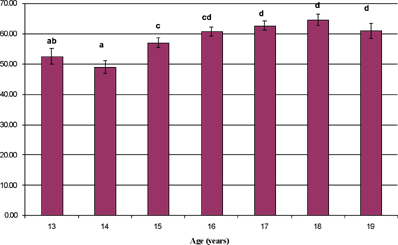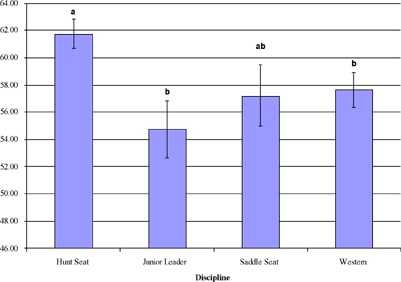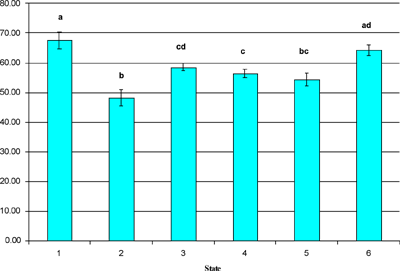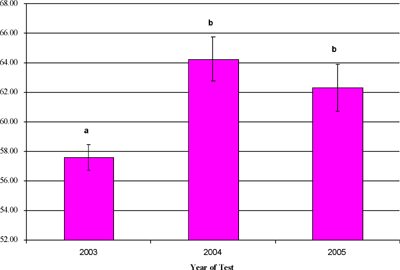October 2007 // Volume 45 // Number 5 // Research in Brief // 5RIB6
Longitudinal Study of the General Knowledge of 4-H Horse Members
Abstract
In the longitudinal (3 year) study reported here, a general knowledge exam was used to determine strengths and weaknesses of 4-H youth in six New England states competing at the Eastern States Exposition 4-H Horse Show. One hundred multiple-choice questions were divided into 10 categories with 10 questions in each category and then randomized. Mean exam scores differed based on age, discipline, state, years of attendance, and test category. This method may offer a way to track progress over time of 4-H youth and assess the effectiveness of targeted program planning in states.
Introduction
There is much interest in determining how 4-H involvement has affected youth, including a recent study on life skill development of youth in horse programs (Smith, Swinker, Comerford, Radhakrishna, & Scheidt-Hoover, 2006). Focusing on one aspect of program participation, such as the general knowledge exam, affords a chance to study changes in a particular program area. The annual Eastern States Exposition 4-H Horse Show offers a unique opportunity to analyze the changes in general knowledge of 4-H youth over time. It includes participation of 4-H youth from six New England states (Connecticut, Massachusetts, Maine, New Hampshire, Rhode Island, and Vermont). Prior to 2003, the exam given at this venue was scored with ribbons awarded based on score.
In 2003, the Connecticut Equine Extension specialist and the Connecticut 4-H Horse Project Coordinator, an Extension educator, categorized the exam in order to determine strengths and weaknesses of the participating 4-H youth. Ten questions in each of these categories were used: anatomy and physiology, breeding, colors, conformation, health and disease, history and evolution, nutrition, reproduction, tack and equipment, and training and behavior. The organizers of the study continued the project with the support of the New England 4-H Horse Show Committee in 2004 and 2005 to longitudinally track the 4-H members of the participating states.
The objective of the study reported here was to track changes in general knowledge over time in order to determine if knowing the strengths and weaknesses in different categories of horse knowledge may help states to better target program planning to address weak areas in its participants.
Materials and Methods
One hundred multiple-choice questions were divided into 10 categories with 10 questions in each category. Categories included anatomy and physiology, breeding, colors, conformation, health and disease, history and evolution, nutrition, reproduction, tack and equipment, and training and behavior. Questions were then randomized so that each category was distributed randomly throughout the exam. The New England 4-H Horse Show Committee critically reviewed the exam. In 2004, the same test was given as in 2003, except that the questions were randomized again.
The test was administered to approximately 100 4-H youth in each year, for a total of 281 participants over 3 years (since some participated in multiple years). They had 2 hours to complete the exam; all of them successfully completed the exam in the time allowed. Some demographic information about each 4-H youth was recorded, including name, gender, birth date, number of years attending the event, discipline (hunt seat, saddle seat, western, or junior leader), and state. Answers were recorded by 4-H youth using Scan-Tron© sheets in the first 2 years of the exam. The third year sheets with blanks were used instead of Scan-Tron© sheets for ease of scoring. It was easier due to the lack of accessibility to a Scan-Tron© machine at the event.
Scan-Tron© sheets or data sheets were then copied and scored by hand for the purposes of the contest. A Scan-Tron© machine was not available at the fairgrounds. The original exams were then processed by the Scan-Tron© system in the first 2 years and by hand in the last year, when it was determined that using the Scan-Tron© system did not make data analysis easier. An average score for each category was calculated for each 4-H youth. These scores were averaged in order to determine results for each state. State results were given to the 4-H leaders of each state for distribution within the state.
Data were analyzed using the mixed procedure in SAS (SAS Institute Inc., 2002-2003). Means that differed at P < 0.05 were considered significantly different. Data were analyzed in two factor designs.
Results
Age (P < 0.01), discipline (P < 0.01), repetition (P < 0.01) (how many years the participant had taken the exam), state the youth was registered in (P < 0.01), and year of the test (P < 0.01) differed significantly.
Mean scores were highest for eighteen (64.64 %), seventeen (62.69 %), nineteen (60.98 %) and sixteen year-olds (60.72 %) followed by fifteen (57.13 %), thirteen (52.60 %), and fourteen year-olds (48.99%) (see Figure 1). Seventeen, eighteen and nineteen year-olds scored higher (P < 0.01) than thirteen, fourteen, and fifteen year-olds. Sixteen year-olds scored higher (P<0.01) than thirteen and fourteen year-olds. There were no significant differences based on gender.
Figure 1.
Mean General Knowledge Score of
Various Ages of 4-H Project Members (n=281)

Note: abcd
Columns with different superscripts were
different (P < 0.01)
When the results were sorted by discipline, hunt seat riders had the highest mean score, followed by western riders, saddleseat riders, and junior leaders (Figure 2). Hunt seat riders scored higher than western riders (P < 0.05) and junior leaders (P < 0.01.
Figure 2.
Mean General Knowledge Score of
Various Disciplines of 4-H Horse Project Members (N=281)

Note: ab
Columns with different superscripts were
different (P < 0.01)
4-H members that participated in the event the longest (6 years) had the highest mean score, followed by participants of 3 years, participants of 5 years, participants of 4 years, participants of 2 years, and finally first-year participants (Figure 3). Participants of six years had a higher (P < 0.05) mean score than first year participants. Participants of 3 years had a higher (P < 0.01) mean score than first- and second-year participants, as well as a higher (P < 0.05) mean score than 4-year participants.
Figure 3.
Mean General Knowledge Score of
4-H Horse Project Members Based on Years of Participation in the
Eastern States Exposition 4-H Horse Show (N=281)

Note: abc
Columns with different superscripts were
different (P < 0.05)
State 1 had the greatest mean score followed by state 6 (64.26 %), state 3 (58.57 %), state 4 (56.40 %), state 5 (54.40 %), and state 2 (48.32%) (Figure 4). State 1 had a higher (P < 0.01) mean score than states 5, 4, 3, and 2. State 6 had a higher (P < 0.01) mean score than states 5, 4, and 2. State 3 had a higher (P < 0.01) mean score than state 2. State 4 had a higher (P < 0.01) mean score than state 2.
Figure 4.
Mean General Knowledge Score of
4-H Horse Project Members Based on Their State of 4-H Horse
Membership (N=281)

Note: abcd Columns with different superscripts were different (P < 0.01)
The mean scores of participants who took the test in 2004 and 2005 did not significantly differ. The mean score of participants who took the test in 2004 and 2005 was higher (P < 0.01) than the mean score of participants who took the test in 2003 (Figure 5). This may not be attributed to an increase in 5- and 6-year participants in these years, since there were only three participants in 2004 who were attending the show for the sixth year, and only two participants in 2005 who were attending the show for the fifth year out of approximately 100 taking the test each year.
Figure 5.
Mean General Knowledge Score of
4-H Horse Project Members Based on the Year They Took the Test
(N=281)

Note: ab
Columns with different superscripts were
different (P < 0.05)
The highest mean scores were in the categories of health and disease (67.08 %), breeds (70.59 %), colors and markings (68.14 %), and anatomy and physiology (66.31%). The next highest mean scores were found in tack and equipment (58.15 %) and training (57.78 %), followed by conformation (52.31 %). The lowest mean scores were in reproduction (51.73 %), nutrition (50.93 %), and history and evolution (46.79 %) (Figure 5). Mean scores for anatomy and physiology, breeds, colors and markings, and health and disease were higher (P < 0.01) than mean scores for conformation, history and evolution, nutrition, reproduction, tack and equipment, and training and behavior. Mean scores for tack and equipment were higher (P < 0.01) than mean scores for history and evolution and higher (P < 0.05) than mean scores for nutrition and reproduction. Mean scores for training and behavior were higher (P < 0.01) for history and evolution and higher (P < 0.05) than mean scores for nutrition and reproduction.
Figure 6.
Mean General Knowledge Score of
4-H Horse Project Members in Various Test Categories (N=281)

Note: abcd
Columns with different superscripts were
different (P < 0.05)
Conclusions and Implications
Age, gender, and discipline results were similar to those previously reported (Nadeau, McCabe Alger, Hoagland, & Chameroy, 2004). As in that study, older participants earned higher mean scores than younger participants. No significant difference was found between the mean test scores of males (n = 17) and females (n = 264). Discipline results were not surprising, because junior leaders would be expected to score lower than hunt seat, saddle seat, or western participants, as they tend to be the youngest and (generally) least experienced group. Hunt seat participants continue to score higher than their western counterparts, as found in the first year of data collection (Nadeau et al., 2004). Although this difference is significant, we are hesitant to draw any conclusion as to the increased knowledge of this particular group at this time. Further study is needed to see what other factors may attribute to this difference.
In the study reported here, performance peaked at 6 years of attendance. The next highest mean scores were earned by participants who had participated for 3 years. In our first study, we found that performance peaked at the third year of attendance and then showed no increase (Nadeau et al., 2004). We postulated that maximum performance may be achieved after 3 years of attendance. With more data collected, it appears that attending for the maximum length of time results in participants earning the highest scores, followed by third-year participants. We also found that participants of 3 and 6 years scored significantly higher than first-year participants. This may be expected, because the first-year participants are new to the event. Third-year participants also earned higher mean scores than second-year participants, as may be expected. More study is needed to determine why fourth- and fifth-year participants do not score higher than third and first year participants.
As in our first study, some states had higher mean scores than others, and these states may be targeting certain categories of knowledge more effectively (Nadeau et al., 2004). Some states have visited other states educational events to increase knowledge of attendees.
Test year does seem to play a role in the outcome of this study. Mean scores were lowest in the first year of the study, then increased when the same test was repeated in 2004. Scores did not differ in the last two years of the test, even though a new test was used.
Because mean test scores over the 3 years ranged from 57 to 64, it is obvious that there is room for improvement in every category. One goal of the New England 4-H Horse Show Committee after examination of the test results is to encourage 4-H participants to achieve higher scores in every category. For this reason, incentives have been developed to reward 4-H members who score high on the test.
Participants had similar strengths and weaknesses in all categories. As mentioned in a previous study, the highest mean scores were in the categories of health and disease, breeds, colors and markings, and anatomy and physiology (Nadeau et al., 2004). The next highest mean scores were found in conformation, tack and equipment, and training. The lowest mean scores were in nutrition, reproduction, and history and evolution. This indicates that the areas of nutrition, reproduction, and history and evolution are areas that have the most room for improvement by participants.
In the future, the organizers of the study reported here hope to develop educational packets that may help strengthen these areas and offer them to the six New England states for participants to study prior to the event. This would offer a means of preparation for the exam, and help states add to the knowledge base of 4-H youth. Results could be assessed after use of this material in the states to see if it has an effect on raising mean general knowledge scores.
This system might have potential for inclusion in the national hippology contests due to its simplicity and potential benefit to coaches, Extension educators, Extension specialists, and 4-H youth. This seems to be an effective method of tracking growth of an individual 4-H member as well as the success of targeted program planning in states.
References
Nadeau, J., McCabe Alger, E., Hoagland, T., & Chameroy, K. (2004). Use of a randomized , categorized exam to determine horse knowledge of 4-H horse show participants. Journal of Extension [On-line], 42(3). Available at: http://www.joe.org/joe/2004june/rb5.shtml
SAS Institute Inc.(2002-2003). The SAS system. Version 8. Cary, NC.
Smith, C. E., Swinker, A. M., Comerford, P. M., Radhakrishna, R. B., & Scheidt-Hoover, T. (2006). Horsemanship and life skills of youth in horse programs. The Professional Animal Scientist, 22(1), 89-93.
